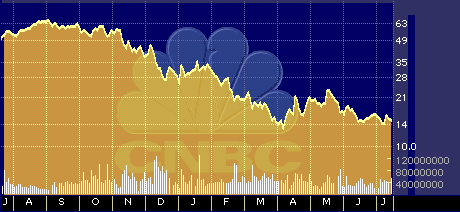
Sun’s Magic Is Its Servers
Sun’s Magic Is Its Servers
by Hal Plotkin
Silicon Valley Correspondent
Sun Microsystems Inc.’s {SUNW} splashy Java and Jini software and its next-generation high-performance multimedia chip, Majc, have captured a lot of attention recently.
But it’s Sun’s success selling high-end UNIX servers, used in internal corporate networks and to power Web sites, that led Credit Suisse First Boston analyst Amit Chopra to reiterate his “buy” rating on the company’s stock.
“Sun is already receiving large orders for the December quarter,” Chopra wrote in a report released last Thursday. “These orders include demand for multiple Starfire servers, suggesting that the company is not plagued by any Y2K-related spending slowdown.” The CS First Boston analyst set a 12-month price target of $85 for Sun.

SUNW 52-week price chart
SUN MICROSYSTEMS INC (NNM:SUNW)
| Analyst pinions | Average Recommendation | Earnings Per Share | |||
| Strong Buy | 10 | This Week | 1.7 | Last Quarter | 0.48 |
| Buy | 9 | Surprise | 0.01 | ||
| Hold | 4 | Percent | 2.12% | ||
| Sell | 0 | Consensus EPS | |||
| Strong Sell | 0 | This Year’s | 1.41 | ||
| Next Year’s | 1.69 | ||||
SUN MICROSYSTEMS INC – SUNW ranks 87 out of 99. It is in the Computer/computer systems industry.
Analyst Ratings compiled by Zacks
Sun’s Starfire server, used mainly for data-intensive applications such as e-commerce Web sites, has been winning raves lately, and not just from Chopra.
Last week, the company announced that its Enterprise Starfire 10000 server beat its previous results in the SAP Retail Standard Application Benchmark Test, which measures server performance. The top-of-the-line Sun server processed more than 2.4 million transactions in one hour, almost double the results achieved during the same test last year.
“Intel owns the low-end of the server market, IBM is still strong in very top-end data centers, but Sun is clearly the leader in mid-tier UNIX-based servers,” says Michael Vizard, executive news editor of Infoworld, a trade publication based in San Mateo, Calif. According to International Data Corp., Sun controlled 65 percent of the market for high-end UNIX servers during the first quarter of this year.
There had been worries that Palo Alto, Calif.-based Sun might suffer from its public association with the hardware and software glitches that crashed the eBay.com Web site several times in recent weeks. eBay, {EBAY} an online auctioneer, is a Sun customer.
“It turns out it wasn’t all Sun’s fault,” says Tim Bajarin, an industry consultant who heads Creative Strategies Research International in Campbell, Calif. “There were several other factors involved, including management issues. It would be a mistake to count Sun out because of that,” he says.
About 10 years ago, Bajarin predicted that large, mainframe computers would make a comeback as “media servers,” something that is just now beginning to happen.
“Really, we haven’t even gotten to that point yet, we’re just beginning to touch the surface of what the Internet will do business to business, let alone business to consumer,” he says. “It’s not anywhere close to what it will be.” Bajarin says Sun’s position as a leading supplier of servers for e-commerce-related Web sites gives the company an advantage as the market grows.
So what about Java and Jini?
Despite considerable industry interest, it will be at least three years, maybe as many as five or 10, before we know if those technologies are going to take off, says Larry Perlstein, principal analyst at Dataquest, based in San Jose, Calif.
Java is a software language that lets different types of computers use applications, such as word processing or online tax preparation, over a network.
“The question is, when will users have the bandwidth they need to regularly use applications over a network?” Perlstein says. He adds that the relatively slow speed of most Internet traffic makes people more comfortable with desktop programs rather than programs that reside on a network.
Sun’s Jini, on the other hand, is software that automatically connects electronic devices, such as pagers, cell phones, computers, and personal digital assistants.
The first Jini devices are scheduled to be released by the end of the year. Even so, it’s an open question whether Sun’s Jini software will win the battle to become the glue that ties together the wide variety of electronic devices consumers are expected to purchase in the future.
Even if Jina and Java do turn out to be illusions, what’s more important, say industry observers, is that Sun stands an excellent chance of extending its winning position in the lucrative market for high-end UNIX servers.
In a few years, Sun may face sharper competition from servers using Intel’s next-generation Merced chip. “In the meantime, though, Sun still has a good two-year lead,” Vizard says.


